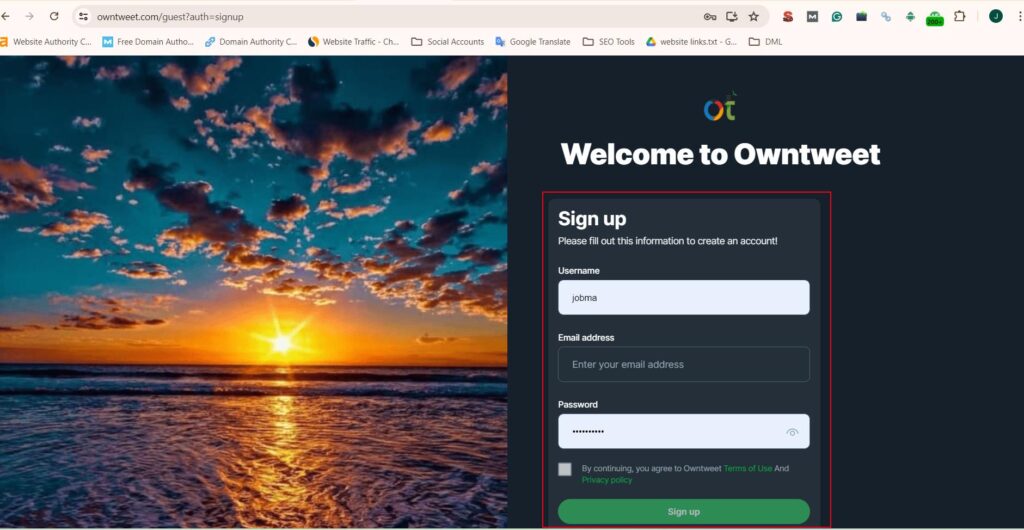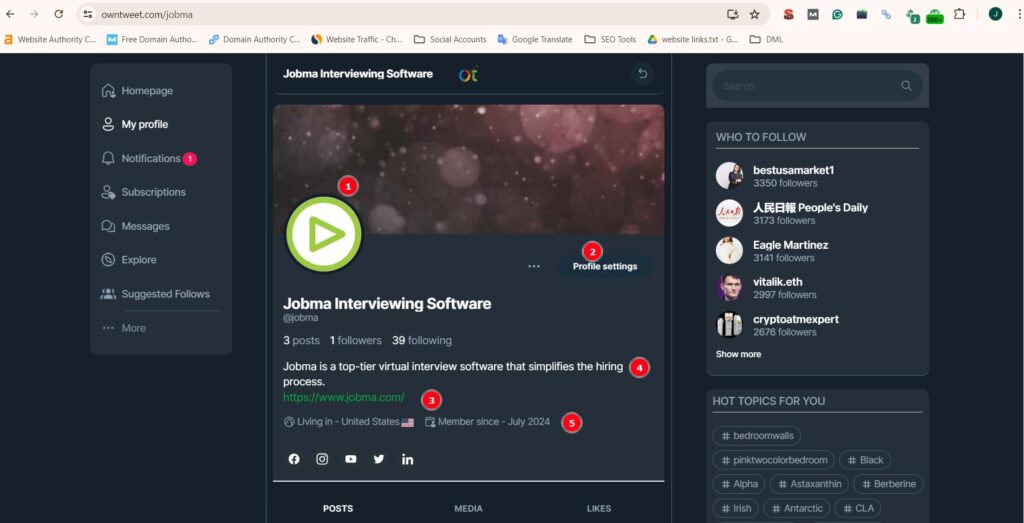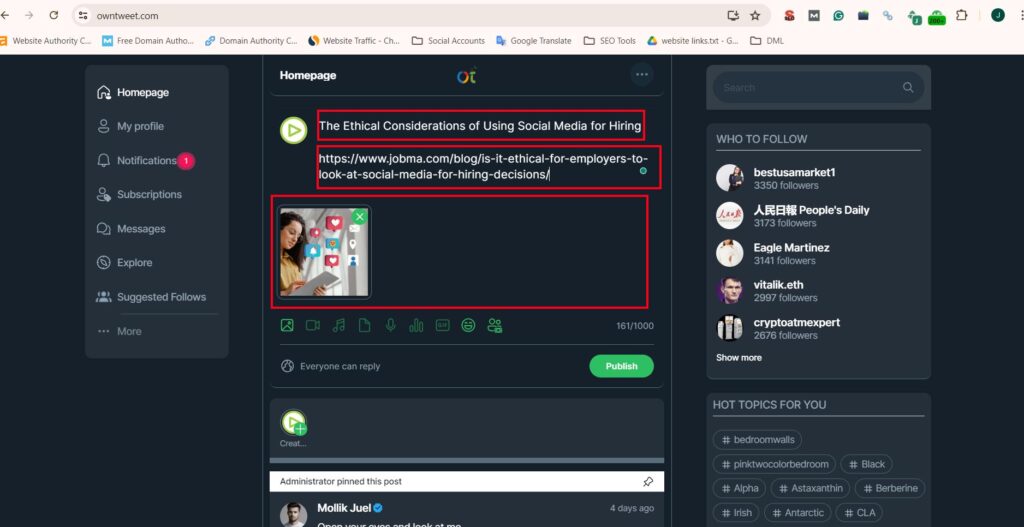
In the digital age, visuals reign supreme. Images are very powerful tools that can significantly enhance your online presence and boost your SEO efforts. However, not all image submission sites are created equal. To truly benefit from image submission, it’s essential to identify and use the right platforms. That’s where we come in.
We’ve compiled a list of the best image submission websites that are effective and reliable. This guide will not only introduce you to these sites but also explain the basics of image submission and its importance for your SEO strategy.
Types of Image Submission Sites: Where to Showcase Your Work
The online world thrives on visuals, and image submission sites offer a fantastic platform to share your photography and graphic design with a global audience. But with so many options available, choosing the right one can be tricky. In this blog post, we’ll explore the two main categories of image submission sites: Free and Paid. We’ll delve into the pros and cons of each, helping you decide where to best showcase your work and achieve your creative goals.
Free Image Submission Sites: Sharing Your Passion
Free image submission sites are like online galleries open to everyone. You can upload your photos and showcase your talent to a broad audience. Here’s the good news:
- Free exposure: Get your work seen by millions without spending a dime.
- Build a following: Connect with other photographers and potential clients.
- Test the waters: Experiment and get feedback before going pro.
However, keep in mind:
- Competition can be fierce: Standing out requires strong photos and strategic tagging.
- Limited control: You might not have complete control over how your images are displayed or used.
- Monetization options may be scarce: Earning money directly from your uploads might be limited.
Top Free Image Submission Sites: Showcase Your Work and Gain Recognition
Sharing your photos on free image submission sites is a fantastic way to gain exposure, connect with other creatives, and build your portfolio. Here are some of the best platforms to consider:
Flickr:
Description: A well-established online community for photographers of all levels.
- Organize photos into albums and sets.
- Share and discuss photos with other users.
- Participate in groups and forums.
- Offer prints and sell licenses (through an optional Pro account).
Submission Guidelines:
- Free accounts allow 1000 photos.
- Photos must be high-resolution (at least 1024 pixels on the longest side).
- Follow community guidelines for respectful behavior and appropriate content.
Example: Imagine a breathtaking landscape photo you captured, and uploaded to Flickr with detailed tags like “mountain range,” “sunrise,” and “hiking adventure.” You can then share it in relevant groups and spark discussions with fellow photography enthusiasts.
Pexels:
Description: A curated platform known for its high-quality, royalty-free images. Great for bloggers and designers seeking free visuals.
Key Features:
- Strict quality control ensures stunning visuals.
- Images are free to download and use commercially.
- Simple search function with relevant keywords.
Submission Guidelines:
- Photos must be high-resolution and meet quality standards.
- Images should be original and not infringe on copyrights.
- Submitting requires agreeing to Pexels’ license, allowing free use by others.
Example: You captured a vibrant close-up of a flower. Upload it to Pexels with tags like “macro photography,” “nature,” and “flower details.” This could be a valuable resource for designers creating nature-themed websites.
Unsplash:
Description: Another popular platform known for its beautiful, royalty-free stock photos.
Key Features:
- Wide variety of images in different styles and categories.
- Images are free to download and use commercially, with attribution to the photographer preferred.
- Vibrant community of photographers and creatives.
Submission Guidelines:
- Photos must be high-resolution and meet quality standards.
- Images should be original and not infringe on copyrights.
- Submitting requires agreeing to Unsplash’s license, allowing free use with attribution.
Example: You took a captivating street photography shot. Uploading it to Unsplash with tags like “urban life,” “cityscape,” and “street photography” could expose your work to a large audience searching for these themes.
Paid Image Submission Sites: Turning Your Passion into Profit
Paid image submission sites take things a step further. By investing a small fee, you open doors to:
- Sell your work: License your photos and get paid whenever someone uses them.
- Higher quality control: Attract serious buyers and showcase your work professionally.
- Exclusive features: Some sites offer advanced analytics, portfolio tools, and contests.
But remember, with great opportunities come some considerations:
- Costs involved: Subscriptions or fees per upload can add up.
- More competition from pros: You’ll be competing against established photographers.
- Not a guaranteed income: Selling photos takes time, effort, and marketing savvy.
The choice ultimately depends on your goals. If you’re starting out, free sites are a fantastic way to build your skills and audience. For those aiming to turn photography into a career, paid sites offer exciting monetization possibilities.
Top Paid Image Submission Sites: Turn Your Talent into Profit
Free image submission sites are great for building an audience, but if you’re looking to monetize your photography skills, paid sites offer exciting possibilities. Here’s a look at some of the top platforms:
Adobe Stock:
Description: A comprehensive platform from the design giant Adobe, offering a vast library of high-quality stock photos and illustrations.
Key Features:
- Reach millions of creative professionals like designers, marketers, and publishers.
- Sell photos with various licensing options (royalty-free and rights-managed).
- Detailed contributor dashboard tracks earnings and downloads.
- Integrates with other Adobe Creative Cloud applications.
Pricing Details:
- Royalty-free earnings vary depending on file size and license purchased.
- Requires an Adobe ID to become a contributor.
Submission Guidelines:
- High technical quality and creative content are essential.
- Images must be original and not infringe on copyrights.
- Adobe curates submissions, so strong portfolios are recommended.
Example: Imagine you captured a stunning portrait photo with perfect lighting and composition. Uploading it to Adobe Stock with relevant keywords like “portrait photography,” “professional headshot,” and “business image” could attract potential buyers looking for high-quality stock photos.
Shutterstock:
Description: A leading global marketplace for royalty-free stock photos, illustrations, and videos.
Key Features:
- Massive user base with a high demand for diverse and high-quality visuals.
- Flexible pricing options for both buyers and sellers.
- Advanced contributor tools for keyword research and portfolio management.
- Regular contributor contests and challenges with cash prizes.
Pricing Details:
- Royalty-free earnings depend on the download size and license type.
- Offers different subscription plans for contributors with varying commission rates.
Submission Guidelines:
- Strict quality control ensures a professional library.
- Uploading requires keyword optimization for discoverability.
- Focus on unique and commercially relevant images.
Example: You have a collection of captivating travel photos showcasing different cultures and landscapes. Uploading them to Shutterstock with tags like “travel photography,” “adventure,” and “cultural immersion” could reach a wide audience of travel bloggers and marketing agencies.
Getty Images/iStock:
Description: A powerhouse in the stock photo industry, offering premium royalty-free (iStock) and rights-managed images (Getty Images).
Key Features:
- Two distinct platforms cater to different budget needs (iStock for affordable options, and Getty Images for high-end visuals).
- Excellent reputation attracts high-paying clients and agencies.
- Contributor support and educational resources for photographers.
Pricing Details:
- Royalty-free earnings vary on iStock based on download size and license type.
- Rights-managed pricing depends on individual negotiation with buyers on Getty Images.
Submission Guidelines:
- Extremely high-quality standards for both platforms.
- Content should be unique and commercially appealing.
- Requires a strong portfolio demonstrating professional skills.
Example: You captured a series of architectural photos showcasing iconic landmarks around the world. Uploading them to Getty Images/iStock with relevant keywords like “architecture photography,” “travel destinations,” and “cityscapes” could attract clients looking for premium visuals for travel publications or architectural projects.
How to Create Image Backlinks: Step-By-Step Guide
Backlinks are a vital component of any successful SEO strategy, and image backlinks are a powerful way to enhance your website’s authority and visibility. An image backlink is created when another website links back to your site through an image. This not only drives traffic but also improves your search engine rankings. In this guide, we will walk you through the process of creating image backlinks, providing clear and actionable steps to boost your SEO efforts. Let’s dive into the step-by-step process to create effective image backlinks.
Step 1
First, you will choose any image submission platform then you will create your profile.

Step 2
Once you create your profile, the time is to optimize your profile details, using the same company details that increase your citations.

Step 3
Once you optimize your profile, now is the time to start submitting images. Will image submission you will use an image title, and description, if possible you will use your respective URL, and drive traffic from there.

Final Step
Once you create your image backlink, you have to check your image backlink incognito and verify the details you provided.

Top 10 Image Submission Sites List
| S.No | Top 10 Image Submission Sites | DA |
| 1 | 94 | |
| 2 | 94 | |
| 3 | Pixabay | 94 |
| 4 | 96 | |
| 5 | Flickr | 92 |
| 6 | 93 | |
| 7 | Imgur | 92 |
| 8 | Photobucket | 93 |
| 9 | DeviantArt | 90 |
| 10 | Google Photos | 94 |
Top 100+ Verified Image Submission Sites List
| Explore Different Types of Backlinks for Your Website! |
| Profile Creation Sites List |
| Social Bookmarking Sites List |
| Article Submission Sites List |
| Business Listing Sites List |
| Directory Submission Sites List |
| Web 2.0 Submission Sites List |
Importance of Image Submission for Your Business
Boost Online Visibility
Image submission enhances your online visibility, especially for new businesses. High-quality images can improve your domain authority and attract more visitors.
Improve Site Ranking
Submitting images to high-quality sites creates valuable backlinks, boosting your site’s search engine ranking and driving more traffic.
Drive Traffic and Engagement
Visuals attract attention. High-quality images make your content engaging, increasing click-through rates, conversions, and sales.
Enhance SEO
Optimize images with relevant keywords. Submitting them to relevant sites improves your search engine ranking, driving organic traffic.
Build Brand Recognition
Consistent, high-quality visuals create a strong brand identity, making your business memorable and trustworthy.
Boost Social Media Presence
Compelling images are more shareable on social media, expanding your reach and generating buzz.
Tips for Effective Image Submission
- Quality: Use high-resolution, professional images.
- Relevance: Ensure images match your content and audience.
- Optimization: Add keywords to titles, alt text, and descriptions.
- Platforms: Submit to industry-relevant sites.
Leveraging image submission effectively enhances your online marketing efforts and achieves business goals.
Why Submitting Images is Essential: Enhancing Your Online Presence
In today’s visually-driven online landscape, image submission plays a crucial role in boosting your website’s visibility and improving its search engine rankings. Whether you’re a photographer, designer, or business owner, understanding the importance of image SEO can significantly enhance your online reach. Here’s a comprehensive guide to why submitting images is necessary and how to do it effectively.
The Importance of Image SEO
Image SEO refers to the practice of optimizing images so that they can be easily crawled and indexed by search engines. Unlike text, images require specific optimization techniques, such as adding alt tags, to ensure they are searchable. Proper image submission can drive more traffic to your website and improve your overall SEO performance.
A good image submission must contain these following aspects
1. Proper Image Selection
Selecting the right image is the first step. Ensure that the images you choose are original, high-quality, and free of watermarks. Avoid using copied or poorly edited images, as image-sharing websites may reject them. Fresh and unique images are more likely to engage viewers and enhance your site’s credibility.
2. Proper Image File Format
Choosing the correct image file format is vital for search engine optimization. The most commonly used formats are JPEG, GIF, and PNG. These formats are preferred because they balance quality and file size, ensuring that images load quickly without compromising on visual appeal.
3. Image Optimization
Optimize your images to maintain quality while reducing file size. This improves website loading times, which is crucial for both user experience and SEO. Use tools (https://tinypng.com/) and techniques to compress images without losing clarity, making them web-friendly and fast-loading.
4. Alternative Text (Alt Text)
Alt text is often overlooked but is essential for SEO, The character limit for image ALT tags should not exceed 125 characters. It provides a textual description of the image, which search engines use to understand the content of the image. A well-crafted alt text not only improves accessibility for visually impaired users but also enhances search engine indexing.
5. Image Description
An effective image description further defines the image and its context. Image description should be concise, relevant, and include targeted keywords. Proper image descriptions help search engines understand the image better, thereby improving your SEO results.
